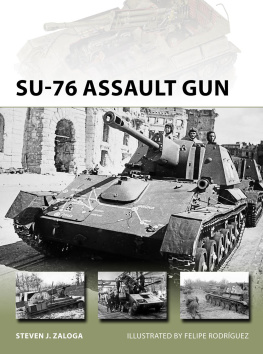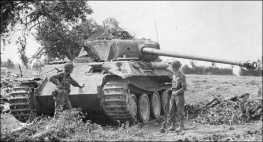STEVEN J. ZALOGA
CONTENTS
INTRODUCTION
The use of tanks for the close support of infantry units was one of the most controversial tactical dilemmas of World War II. Germanys Blitzkrieg victories in Poland in 1939 and France in 1940 suggested that tanks should be concentrated in armored divisions and that none should be diverted to infantry support at the small-unit level. Yet the Wehrmacht itself soon learned the value of specialized infantry-support armored fighting vehicles (AFV), both in the form of the tank destroyer (Panzerjger) and assault gun (Sturmgeschtz). By 1944, more than a quarter of German AFVs were committed to the infantry-support role, and by the end of the war, they were the majority in some theaters. This book explores this tactical conundrum by pitting two of the pre-eminent AFVs against each other in combat, the German StuG III assault gun and the American M10 tank destroyer. The encounter that serves as the focus of this book took place in early October 1944 on Germanys western border near Aachen, when the US XIX Corps attempted to penetrate the Scharnhorst Line that was being defended by the German LXXXI. Armeekorps.
The StuG III and the M10 3in Gun Motor Carriage (GMC) may seem an odd combination for consideration in the Duel series since they were designed for different tactical roles. The StuG III was originally developed as an assault gun for direct infantry support, while the M10 was developed as a tank destroyer to combat the Panzer force. Yet the StuG III gradually evolved into one of the Wehrmachts most effective tank destroyers on the Eastern Front, and the M10 was often used in the assault-gun role by the US Army in the European Theater of Operations (ETO). By 1944, they had both evolved into multipurpose AFVs and were used to provide armored support for infantry units.
Neither vehicle has attracted as much attention as the more famous Tiger, Panther, and Sherman. Yet the StuG III was one of the most widely produced German AFVs of World War II. Although it started the war as a relatively minor type, by 194445 it often outnumbered the PzKpfw IV and Panther on the battlefield. The M10 was a specialized derivative of the famous Sherman tank. It saw extensive combat use starting in Tunisia in 1943, and on through Sicily, Italy, and Northwest Europe, and even in the Pacific and on the Eastern Front.
The principal role for the StuG III was infantry support. This is a StuG III Ausf F of 1./StuG-Abt 210 during the fighting in the Kuban in southern Russia in the fall of 1942. (NARA)
The StuG III and M10 were developed to provide alternative tactical approaches to the early tactics of Blitzkrieg warfare. In the late 1930s, the Heer (German Army) had originally intended to provide its infantry divisions with armored support. However, German industry was slow in providing enough tanks for the new Panzer divisions, and so the army concentrated its AFVs in these units. This stood in considerable contrast to other armies of the Great Powers such as France, Britain, and the Soviet Union, which traditionally divided their tank force between the infantry-support tank units and the cavalry/armored force. Germanys stunning defeat of France in 1940 and the decisive role of the Panzer force in this victory convinced many observers that the traditional bifurcation of the AFV force into infantry/cavalry roles was a mistake. This was especially the case in the United States, which was on the verge of creating a massive new armored force and was looking for a model on which to base its future configuration. The US Armys armored divisions were patterned on the Panzer force, but the tank-destroyer concept emerged in 1940 as a distinctly American answer to the Panzer threat. As will be described in more detail below, this proved to be the wrong answer to the wrong tactical question.
Yet the concentration of the Panzer force in 1940 proved to be a temporary fluke. German commanders quickly appreciated Marshal Philippe Ptains famous quote from the 1918 fighting: There are two kinds of infantry: men who have gone into action with tanks, and men who have not; and the former never want to go into action without tanks again. The modern battlefield had become a very dangerous place for the rifleman, and armored support provided a vital ingredient in restoring the offensive capability of the infantry in the face of enemy machine guns, fortifications, and tanks. German commanders had never doubted that infantry-support tanks would be valuable, but they did face the dilemma of how to produce enough AFVs to satisfy both the needs of the Panzer divisions and the infantry. The solution came in the form of a low-cost tank substitute, namely the turretless Sturmgeschtz (StuG) assault gun. This weapon began to appear in tiny numbers in 1940. By the time of the 1941 invasion of the USSR, only about 400 were in service. The StuG III became so popular in the infantry divisions that production continued to expand, from barely 50 per month in 1941 to more than 500 a month in 1944, a ten-fold increase. As the numbers on the Eastern Front continued to grow, so did the StuG IIIs tactical role. The early StuG III was armed with a short 7.5cm gun that had very poor antitank performance. Yet it quickly became apparent that the numerous Soviet tanks represented a persistent threat to the German infantry. As a result, new versions with the long 7.5cm guns began to appear in 1942, and the StuG III gradually evolved into a dual-purpose weapon, both for close fire support of the infantry against unarmored targets, as well as a potent antitank weapon.
In the case of the M10, the process was completely the reverse. Although it had been intended primarily as a method to combat German Panzer divisions, when the M10 was first deployed in Tunisia in 1943, the Panzer threat had evolved. Massed attacks by entire Panzer corps were a thing of the past, at least in the West, and German tanks tended to appear on the battlefield in much more dispersed formations. The performance of US Army tank destroyers in Tunisia in 1943 was so uninspiring that none were deployed in the invasion of Sicily in July 1943. Although they were used in growing numbers in Italy in 194344, encounters with German AFVs were so infrequent that new missions were sought. The M10 ended up being attached to infantry units to provide direct-fire support, and it was also seconded to divisional artillery in some campaigns to deepen its firepower for key indirect-fire missions. Instead of being a dedicated tank destroyer, the M10 gradually evolved into being a multipurpose assault gun, most often used for infantry support. A report by the commander of the US 5th Tank Destroyer (TD) Group in Normandy in 1944 reiterated Ptains maxim:
What is not in the field manuals on tank destroyer use is the effective support that they render to a fighting infantry at the time of actual combat. An infantryman has his fortitude well tested and the mere presence of self-propelled tank destroyers in his immediate vicinity gives a tremendous shot of courage to the committed infantryman. For example, at Chambois during the closing of the Falaise Gap in August 1944, an infantry battalion moved towards the town with utter fearlessness to enemy artillery, mortar, and small arms fire when accompanied by some M10s. However, the M10s were delayed in crossing a stream for about thirty-five minutes. During this time, the infantry battalion continued to their objective, which dominated a roadway leading to Chambois. They fought infantry, they bazooka-ed some armored vehicles including three tanks on the road, but on realizing that the M10s werent firing, they started a retirement. Leading the parade to the rear was a short lad known as Shorty. Shorty in the lead was the first man to see a platoon of M10s who had finally gotten across the stream. Shorty took a good look at the M10s, turned around, and shouted to the other me Hell boys, what are we retiring for, here comes the TDs! The entire company in mass immediately reversed their direction and returned to their excellent positions, and to say they fought for the next few hours with unusual bravery is stating it mildly. The point I am trying to make is that the appearance and the knowledge that self-propelled tank-destroyers were at hand was a major reason that the infantry attained success and victory. Often many men die or suffer to retain or exploit IF the inspiration furnished by the presence of self-propelled tank destroyers is known. The towed guns can be just as brave and thoroughly trained, but they never give much oomph to the fighting doughboy when the chips are really down.




















